How much do websites make from ads? Many publishers constantly ponder this question. The answer is that there’s no limit to how much you can make from a website. It depends on your traffic level, niche, and monetization strategies. This article will dive deep into website monetization and show exemplary case studies to inspire you.
How much money do websites make on average from ads?
Website ads revenue depends on several factors, including niche, traffic level, pricing models, and the type of advertisers. Some website publishers make a few pennies, while others make tens of thousands to millions of dollars.
The average advertising revenue for websites is $1 per 1,000 visitors. However, you can earn much more than this figure if you play your cards right. Here’s a case study of a blogger who earns $800 daily, with traffic largely coming from X (Twitter).
How does ad monetization work?
Many brands want to advertise products to a specific audience. Publishers have websites with these audiences and charge brands to place ads. The brand pays to advertise its product and earn higher revenue, and the publisher collects the money for providing the ad slots.
As a publisher, you can negotiate advertising deals directly with businesses or join an ad network with existing advertising inventory. An ad network is more convenient because the network handles the negotiations, and you can simply tap into the existing inventory. Display advertising networks have made it easier than ever for publishers to monetize their traffic.
How do you measure ad revenue for websites?
Revenue depends on the price you sell your ads and the traffic volume.
- The price is measured by the cost per mille (CPM) – the amount an advertiser agrees to pay for every thousand views (impressions) of their ad.
- Volume is measured by the number of impressions.
- eCPM – (Earnings from ads / Impressions) *1000
Enter your ad network’s statistics dashboard and find the Impressions field. You can filter by domain or date to get more accurate data.
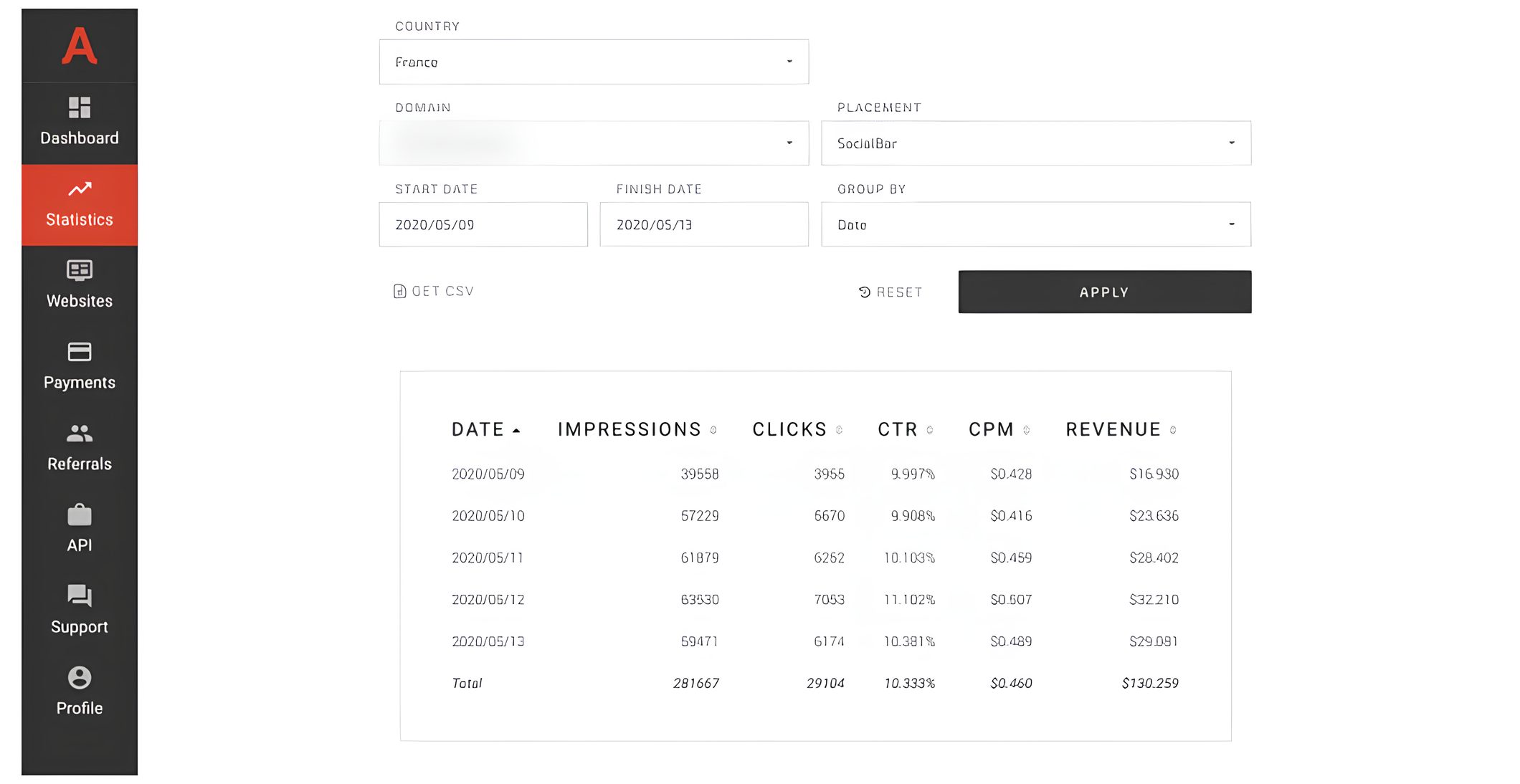
Ensure you have a good understanding of how your network counts ad impressions so that you don’t get confused if the data doesn’t match the exact one from your website’s analytics page.
Multiply the result in the above step by the eCPM (on the Adsterra platform, data in the CPM column equals eCPM). This multiplication gives your ad revenue. eCPM is not a fixed value; lots of factors may cause it to grow or drop.
Publishers should also know about these vital metrics:
- Cost-per-click (CPC): The amount an advertiser agrees to pay for every click their ad gets. Sometimes, advertisers prefer to pay per click instead of per thousand views.
- Click-through rate (CTR): The number of clicks an ad receives divided by the number of times people view the ad. This metric evaluates an ad’s performance.
- Conversion rate: The percentage of ad viewers who completed the desired action. It’s one thing to click on an ad and another to follow the suggested action – the conversion rate measures the latter.
- Return on investment (ROI): The profit an advertiser generates from their ads placed on your website. A higher ROI makes advertising more willing to work with you for further campaigns.
Most popular pricing models and their averages
CPC, CPM, and CPA are just a few pricing models you can use to calculate your website’s ad revenue. The most popular models—CPM and CPC can vary widely by country and industry.
CPM rates
The cost-per-mille, or CPM, is defined as the price per thousand impressions. Advertisers are expected to pay a price for a thousand impressions, regardless of how many clicks these impressions generate. CPM is a little more complicated, as even more factors influence it, making it challenging to obtain precise data across industries. Actually, the most advanced ad networks will calculate an eCPM rate, which allows for getting higher revenues.
CPC rates
It is a business model in which ad revenue is determined by the number of people who click on an ad. In this case, an advertiser pays a price per click, so the publisher’s income depends on ad CTR.
CTR refers to the proportion of people who clicked on an ad versus the total number of people who saw it. So, how much money do you make from advertisements on your site? CTR has an impact on this. Here are some figures showing average CPC and CTR rates by industry and by GEO:
CTR and CPC averages by industry
Some industries perform better than others; for example, dating and financial and consumer services websites have the highest rates. B2B, legal, and real estate businesses are among the other profitable niches. While customer services have low CTR rates.
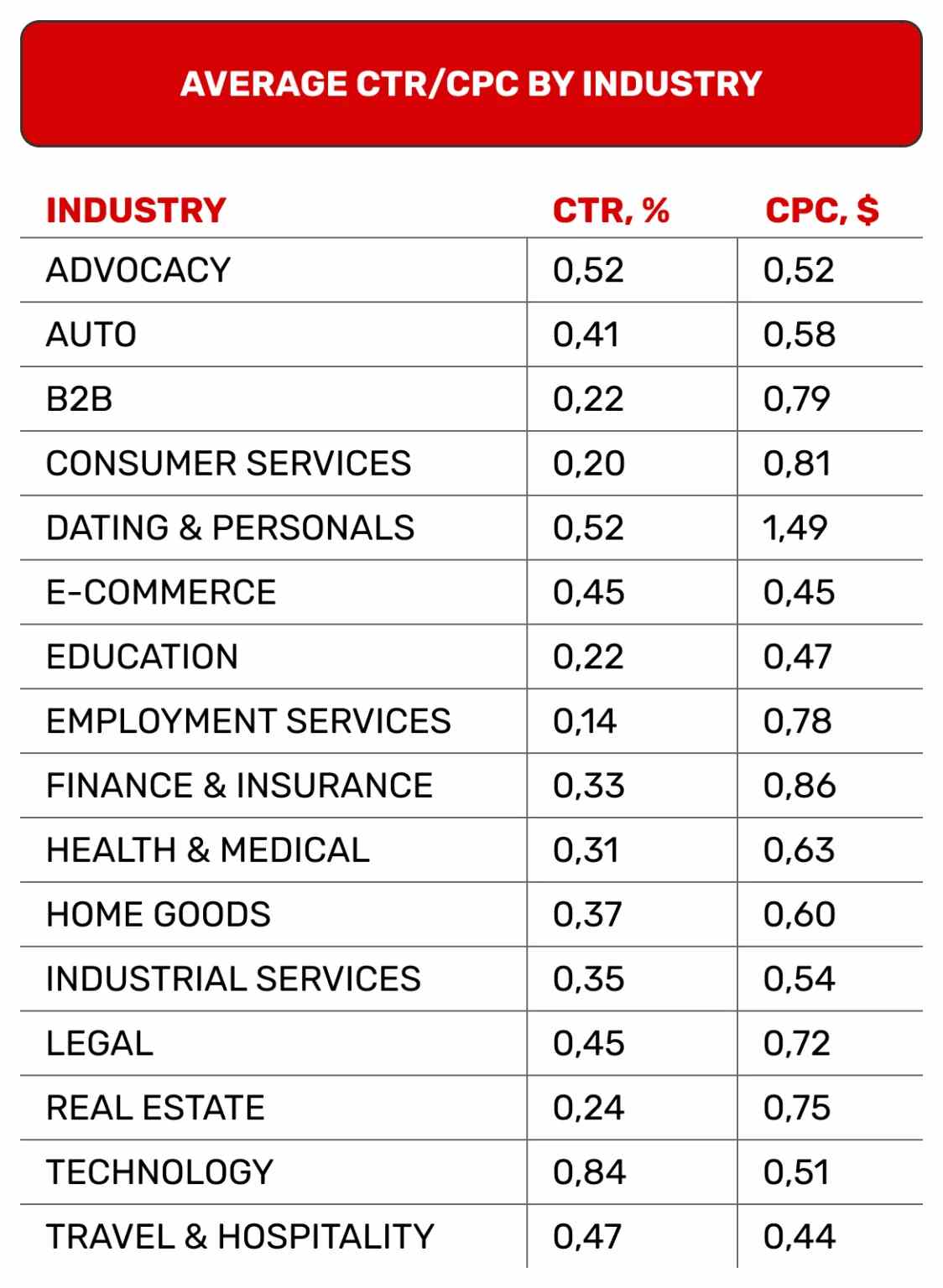
CTR and CPC averages by GEO
Advertisers are expected to pay the most for a click in the United States, Australia, the United Kingdom, and Canada. So traffic from these countries will most likely bring you the most money.
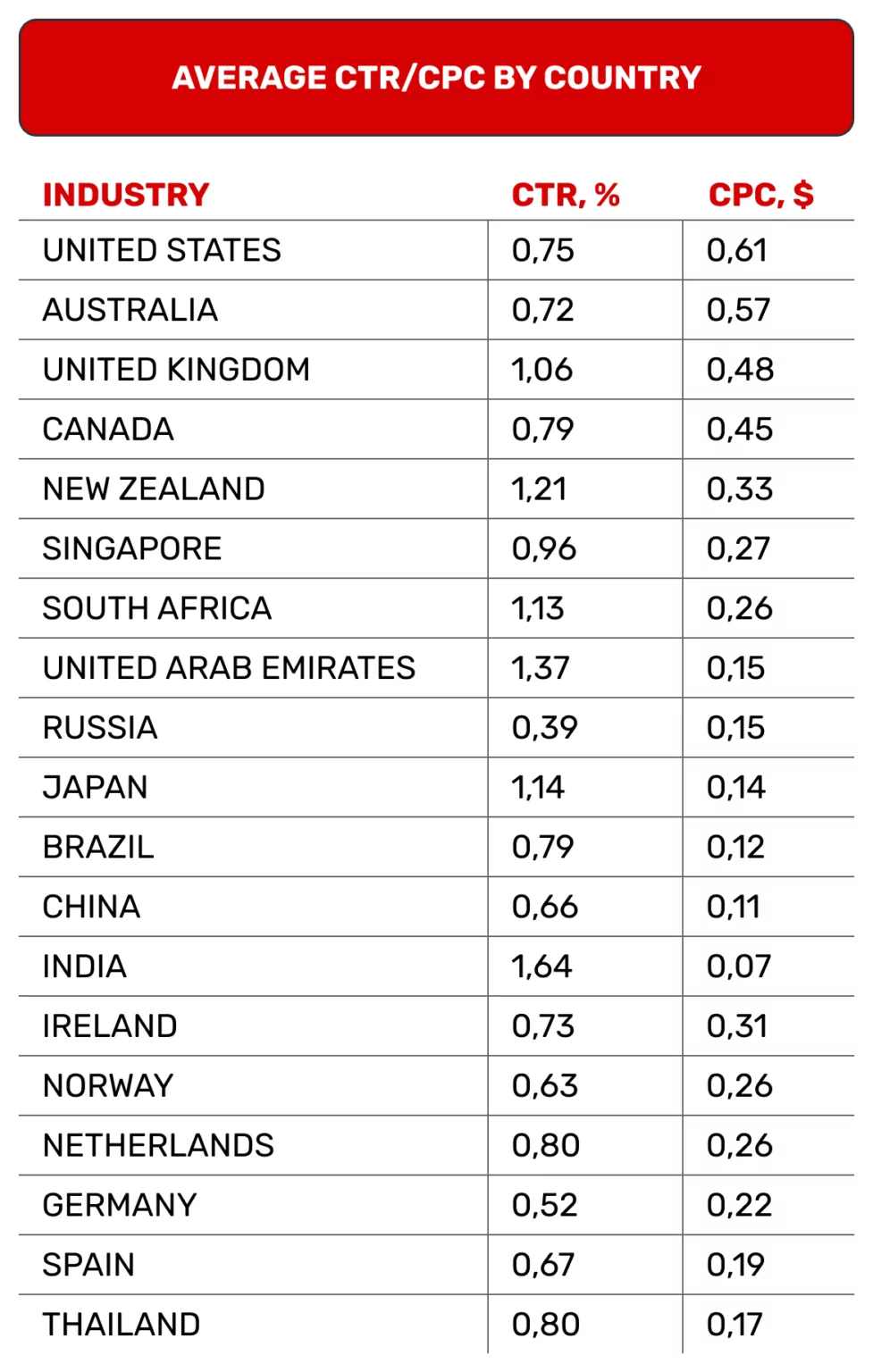
However, India, the United Arab Emirates, and Japan have the highest click-through rates, which may help compensate for their relatively low CPC rates.
Website revenue according to monthly page views
Websites generally earn revenue based on their monthly page views. The rule of thumb is that 500,000 monthly page views earn $1,000 to $5,000; 1 million monthly page views earn $2,500 to $25,000 per month, and so forth.
However, these estimates are not written in stone — some niches can go much higher than the norm. Don’t let online revenue calculators be the final word on how much money you can make from website monetization.
Moreover, many ad networks pay more since they also count conversions from ads (cost-per-action). That’s when you can see $20 or more in the CPM field: the revenue includes conversions. Some publishers can make $2,100 in the span of 2 days.
Estimating website revenue based on ad placements
Ad placement is crucial to every website’s revenue potential. It’s one thing to get an ad for your website and another to place it where it’ll generate the best results. The latter is critical to maximizing your website’s ad revenue.
Let’s examine how different types of ad placements affect your ad revenue:
1. Above the Fold (ATF) placement
ATF ads appear in a web page’s visible area immediately after the page loads. The user doesn’t need to scroll to see them, and their higher visibility spurs higher click-through rates.
ATF ads earn significantly more than other placements because of their greater visibility. However, that doesn’t mean you should crowd the top of your web page with ads — too many ads ruin the user experience and reduce your revenue.
The revenue from Above the Fold ads is typically 1.5x to 2x that of Below the Fold ads.
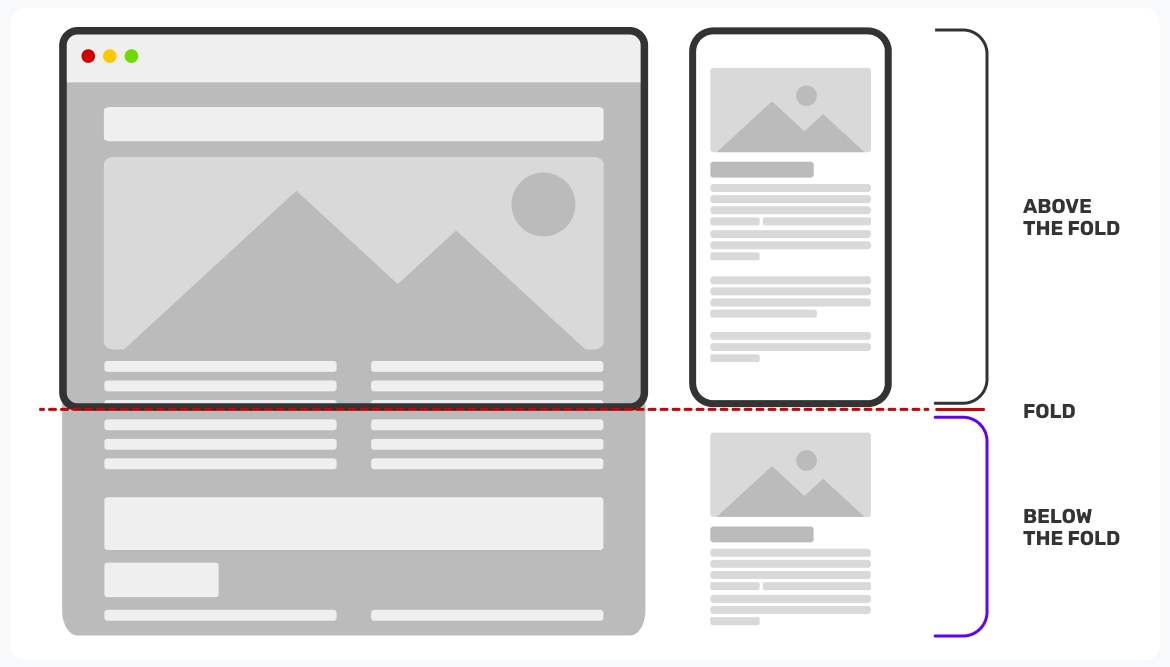
2. Below the Fold (BTF) placement
Below the Fold ads appear between the middle and end of a web page. The user must scroll through the web page before they see these ads. Although they have lower visibility, BTF ads can be very effective, especially for websites with engaged readers. BTF ads work well for news websites where users must scroll to get relevant information. For more information, you can see our article on how to make money from a news website.
3. Leaderboard, sidebar, and footer
Leaderboard, sidebar, and footer are the main types of display ads. A leaderboard is a prominent banner ad at the top of a website. A sidebar ad is placed on a website’s left or right side, and a footer ad is placed at the bottom.
4. Pop ads (Popup and Popunder ads)
Pop ads appear atop or under a webpage. The ones appearing atop are Popups, and those under the page are Popunders. Though it’s an advertising format, we can list it as an ad placement type because Pops employ an alternative mechanic. They don’t require any fixed slot on a web page, which makes them perfect for almost every blog.
Pop ads are highly visible and generate good revenue. However, Popup ads can be annoying and cause users to engage less with your site. Using Popunders to sell advertising is better because they’re less distracting.
5. Interstitials
Interstitials are also a separate type of advertising with their own placement specifics. They cover the viewer’s entire screen. They are the most visible type of ad and earn high revenue. However, be careful about the frequency of displaying Interstitial ads. Show at most 1 or 2 Interstitial ads to the same user per 24 hours. Anything above this level is an ad placement mistake that risks annoying the viewer and making them abandon your site.
Walk through a fast verification (about 10 minutes) and access top-paying ad formats and high-quality offers.
5 factors that determine website revenue
1. Your audience profile
The better you understand your audience, the more value you offer advertisers. Businesses are eager to advertise when they can see detailed data about your website’s audience and certify that it fits their customer profile.
You can use analytical tools like Google Analytics and Kissmetrics to gather detailed data about your audience and present it in a report that advertisers can easily understand. You can post a media kit on your website showcasing this data and encouraging interested brands to contact you.
2. Your site’s focus
Your website’s niche is critical to its profitability. Focusing on a single niche is better than having a generalized website. With a single niche, advertisers are sure about the audience they’re interacting with and more willing to spend big bucks on ads. Some niches also generally pay better than average, such as iGaming, Technology, E-commerce, Sports, Entertainment, Movies, and News.
3. Your audience’s intent
Your audience’s intent greatly affects your ad revenue. Advertisers are willing to pay more for an audience nearing the end of a decision-making process. For example, audiences searching for items to buy are more valuable than those reading generalized information.
Assume a reader named Barbara wants to buy a new laptop and needs clarification about which one to get. She starts searching for “Best laptops to buy,” “Best laptops for gaming,” “Best laptops for students,” and similar terms. You have a product guide website with detailed information about the best laptops to get, and Barbara visits it. Advertisers are willing to pay big bucks to reach out to people like Barbara who are about to spend money on an item. In this case, Barbara is more valuable than a viewer reading generalized articles about laptops and smartphones.
Product review websites tend to earn higher revenue because of their audience’s purchase intent.
4. Your on-page elements
The elements on your web page affect your ads’ visibility and revenue. Ensure elements are well-positioned and don’t interfere with the ads or vice versa. The greater the visibility, the more money you can make from ads.
5. Traffic volume
The higher your website traffic, the more opportunities you have for generating revenue. Websites with higher traffic outearn those with lower traffic. However, it’s not always about having the largest audience. It’s about having an engaged audience willing to respond to advertisements.
How do website publishers make money from ads? 4 proven ways
1. Display ad networks
You can sign up for advertising networks like Adsterra and Google AdSense that make it easy to monetize your traffic. These networks already have an ad inventory you can tap into instead of struggling to negotiate ad deals yourself — Adsterra has over 15,000 reputed advertisers on its network. The most advanced ad networks calculate your revenue based on eCPM and deliver high-paying ads based on your visitors’ geographical locations and traffic volume.
Ad networks provide different types of ads, including Banners, Popunders, Social Bars, Interstitials, etc. Payments are automatically calculated and paid out on agreed dates.
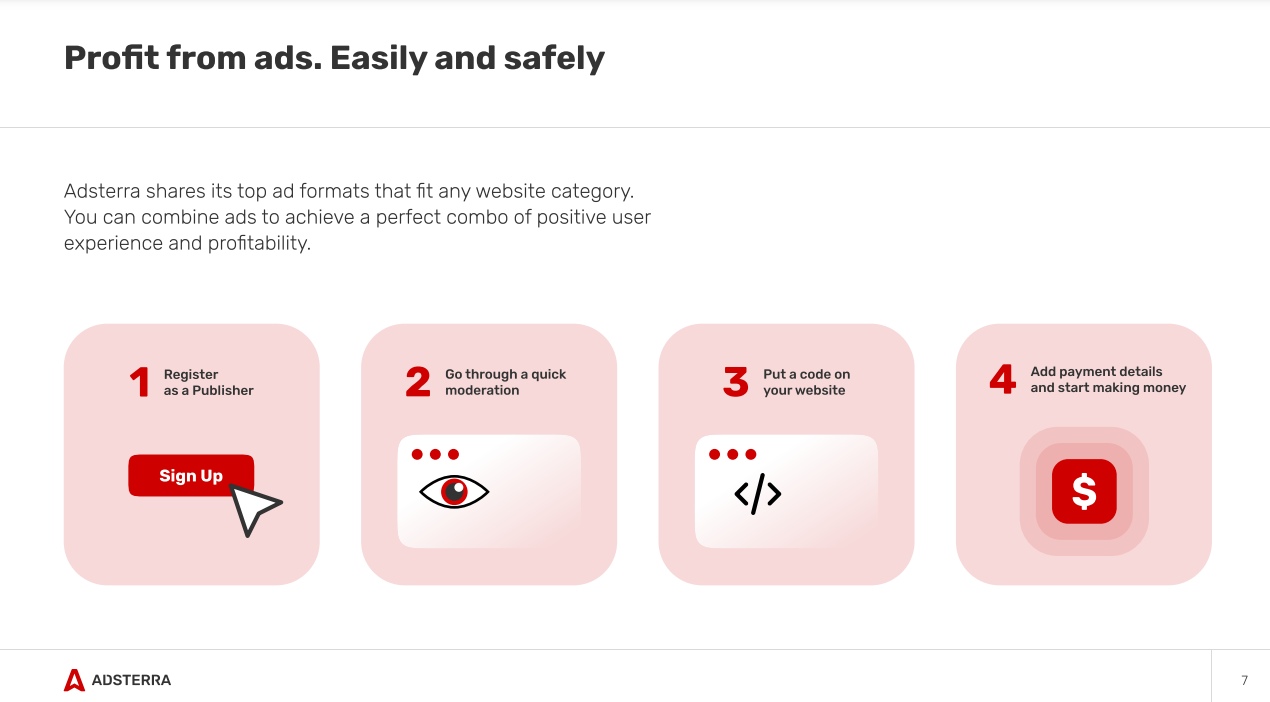
2. Affiliate marketing
Affiliate marketing implies promoting products or services in exchange for commissions. In this model, you earn money for each sale or action you drive for the brand.
Let’s say you run a popular product review site and write a detailed article about the best smartphones for millennials. The article can include affiliate links for the products. If someone reads the article, clicks on the link, and buys the recommended product, you’ll receive a commission from the seller.
Affiliate marketing is effective because it aligns the interests of the advertiser and publisher. The drawback is that you need high traffic and a loyal audience to adopt this monetization model. Newbie websites have little chance of generating revenue with affiliate marketing.
3. Adsterra’s Smart Direct Link
Adsterra’s Smart Direct Link allows you to work with multiple advertisers when your website or blog is new. You need to get the link’s code (a typical URL) and place it anywhere on your web page.
The link contains thousands of advertising offers. But your website visitors will get only those relevant to their interests since AI algorithms take into account multiple parameters.
4. Sponsored Content
There are different profitable ways to increase your website ad revenue with sponsored content. You agree to add a link to the advertiser’s page in exchange for some payouts. This way, you can keep your website content consistent in style and charge advertisers for a link and content production. Depending on the niche, a sponsored post can cost between $150 and $300.
Consider the following content as an alternative:
- Record a sponsored podcast;
- Sell ad banner placement directly to the interested advertiser for the price and time you want;
- Form a brand partnership to expand your visitor base by mutual promotion with a partner.
5. Paid products and services
You can sell paid products and services relevant to your website’s audience. The key is to first gain their trust by providing high-quality content. Afterwards, you can sell items to an audience that trusts you.
Examples of things you can sell include
- Educational courses
- Merchandise
- Tickets to physical and online events
- Coaching sessions
- Consulting services
For example, Ron Stefanski, a digital marketing professor, offers consulting services to brands and individuals who want to promote their products. His website, OneHourProfessor.com, has established a solid reputation, allowing him to convert that reputation into income.

The most profitable ad niches
These are some of the most profitable niches to earn ad revenue from a website:
1. iGaming
iGaming is a lucrative industry worth over $60 billion. Many iGaming brands are willing to pay top dollar to advertise to their perfect audience. Running a website in this niche can be lucrative if you get significant traffic. You can partner with iGaming brands and earn sizeable amounts from display ads or commissions for new signups.
2. E-commerce
E-commerce is another lucrative niche, especially when you’re running affiliate ads. You can promote products and earn commissions when your readers purchase the recommended products. There are endless things to promote, such as clothing, accessories, jewelry, electronics, kitchen appliances, and books. You can earn healthy commissions if you have a highly engaged audience.
3. Software and Technologies
Software is gradually eating the world and has become one of the most profitable niches for publishers. Most people aren’t technical, so they seek expert knowledge when choosing software tools. Publishers providing this knowledge can earn lucrative amounts by advertising software products to their audience. Writing software reviews and including display ads or affiliate links is a high-paying niche.
4. Entertainment
Entertainment websites can generate considerable revenue with the right strategy. Many people seek movies, music, books, or even memes online, and providing what they want can help you attract high engagement. You can then promote similar entertainment products to your audience and earn healthy affiliate commissions or eCPM payments.
How to increase ad revenue for your website
Traffic is the first thing to consider when talking about increasing ad revenue. The more traffic you get, the more you can make money from a website. You can optimize your website’s content to rank high on search engines by using the right keywords and creating informative content. A higher search engine ranking gives you more organic traffic to monetize.
Another thing to consider is the relevance of your traffic. Some publishers get obsessed with traffic volumes. Advertisers, on the other hand, want to pay for real views and clicks. If your audience is not massive yet but willingly watches ads and converts, you will definitely get good revenue.
If you monetize with affiliate links, only advertise things your audience can relate to. For example, a fashion blog should promote fashion items rather than electronics. The more relevant your ads are, the more conversions you can get from them. You can conduct A/B tests for different ad placement variations to see what works best for your website.
Real figures
Let’s examine some real figures of publishers who earn lucrative amounts from their websites.
1. Direct Link Monetization: $2000 From Scratch
Jeremiah Yahaya is an entertainment blogger from Nigeria. In 2021, he set up a website to deliver entertainment news to a global audience and signed up for Adsterra to monetize his site with ads.
Yahaya placed Adsterra Direct Links on his posts, directing users to relevant external advertisements. This monetization strategy brought great results, giving Yahaya over $2,000 in revenue in a few months.
2. How I Earned $1,200 in 2 months with Adsterra ads
Achille Anne is a blogger and content creator who passionately writes about entertainment for a global audience. Her website covers up-to-date news and events in the entertainment sector, delivering a fresh stream of content optimized to rank high on search engines. Anne used a mix of Popunders, Banners, and Social Bar to earn over $1,200 in two months from her blog.
Conclusion
How much money do websites make from ads? You’ll get varying answers if you ask this question. Indeed, the answer depends on several factors, like your audience location, traffic, and niche.
Generally, audiences with higher purchasing power and intent are more sought after by advertisers, meaning you can earn more money if you have such an audience.
We’ve dived deep into the question of “how much do websites make from ads?” explaining the different factors affecting it, how to calculate ad revenue, and how ad placement affects revenue.
The most crucial part of website monetization is choosing a reliable ad network that delivers a steady stream of high-paying ads. Adsterra is a leading network that provides publishers with over $87 million in annual ad payouts. Our network of 15,000+ advertisers allows publishers across different niches to earn significant revenue.
